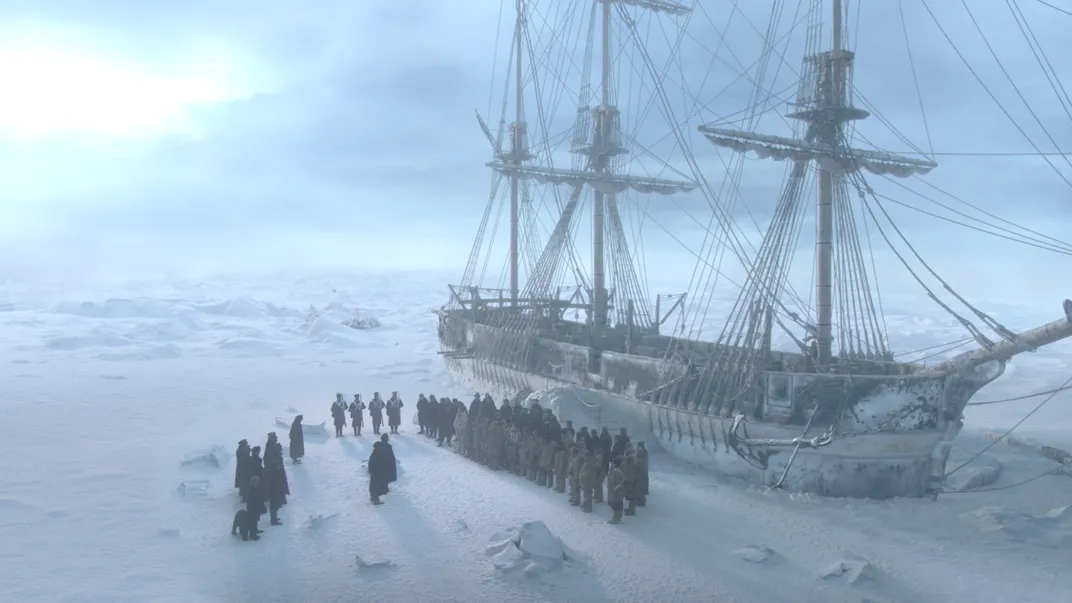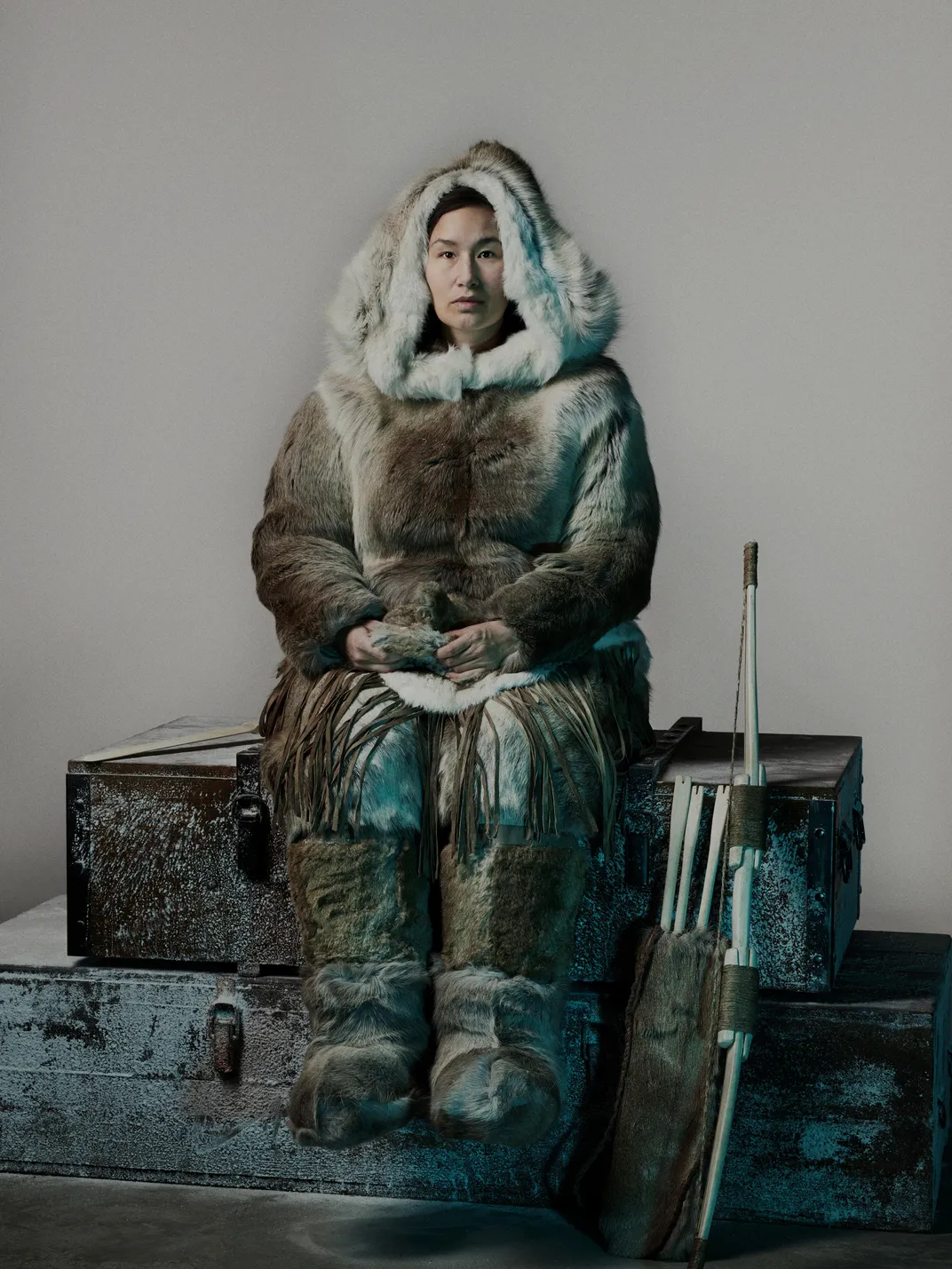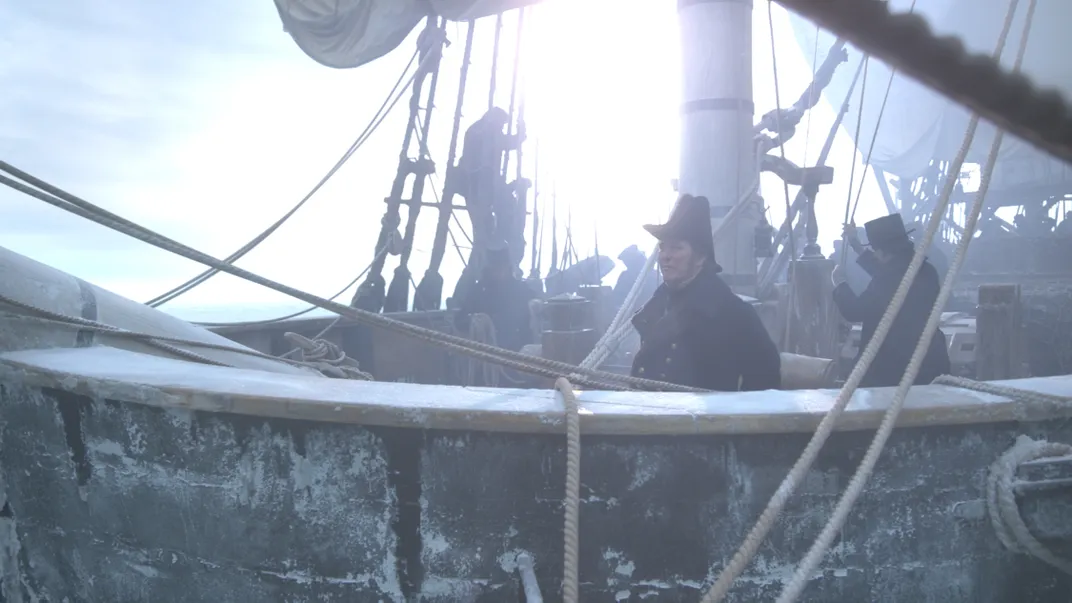Tales of the Doomed Franklin Expedition Long Ignored the Inuit Side, But “The Terror” Flips the Script
The new AMC television show succeeds in being inclusive of indigenous culture
/https://tf-cmsv2-smithsonianmag-media.s3.amazonaws.com/filer/e2/91/e2916a24-0c6d-426a-8fba-018469c02083/terror_103_am_0131_0446-rt.jpg)
In 1845, Arctic veteran Sir John Franklin departed Britain in command of two ships, the HMS Terror and Erebus, to seek the fabled Northwest Passage in the Arctic. They were last seen by Europeans in Baffin Bay, off the coast of Greenland. Then both ships disappeared, seemingly swallowed by the ice and never heard from again, at least not from the explorers themselves.
Those looking for the true story, however, have almost always had access to one primary source: Inuit oral histories, more specifically the accounts of the Netsilik Inuit. As early as 1854, just six years after the expedition was declared lost, a Hudson’s Bay fur trader named John Rae talked to Inuk men he met about the fate of the Expedition.
The Inuit told Rae stories of meeting starving men, and gave him relics of the Franklin Expedition to back up their story. But when Rae brought tales of cannibalism and suffering back to England, he was subject to “a smear campaign initiated by Lady Jane Franklin, the explorer’s scandalized widow, supported by racist writings from the likes of Charles Dickens,” writes Rae biographer Ken McGoogan. In British lore, Franklin and his crew became martyrs to science, good Christian men who suffered a cruel fate at the hands of Mother Nature. Later historians framed Franklin as a hubristic imperialist, and more recently the Canadian government has used Franklin as an argument for Arctic sovereignty.
Inuit stories were marginalized time and time again, until the ships were found in 2014 and 2016 by a coalition that included archaeologists and local historian Louie Kamookak, an expert in Netsilik oral history of the expedition. The sunken wrecks were located deep in the Canadian Arctic, near the Inuit community of Gjoa Haven.
More recent interpretations of the Franklin expedition have included the Inuit, with a planned interpretive center in Gjoa Haven and a government contract out to record oral histories about the expedition. It’s a welcome change, centering the Inuit in their own story and interrogating how the Franklin expedition affected them, rather than the other way around.
Given these different kinds of historical record and the usual temporal and financial constraints of television, it’s striking to see a prestige television drama approach a moment in history with as much care and mindful inclusion as the executive producers of AMC’s “The Terror” are attempting to do. In this new series that attempts its own interpretation of the doomed expedition, the showrunners are also striving to make the Inuit portions of the show as real–or realer–than the English ones and respect the Netsilik Inuit who met Franklin and passed down their stories.

The communities around Gjoa Haven, including Cambridge Bay where the regional heritage center is located, have been eagerly anticipating the show and following it, says Pamela Gross, the executive director of the Kitikmeot Heritage Society. The real drama happened in their own backyard, after all, and there’s more than one Franklin expedition sleuth in Nunavut, including her own father.
Then there’s the fact that AMC sought out Inuk actors and consulted with Inuit authorities to make the show authentic—a marked departure from the way Inuit culture and identity is handled in many other portrayals. “That’s amazing. That’s the type of thing we want,” Gross says.
“We wanted to make sure that if there was someone the inside of [Netsilik Inuit] culture watching the show, that they would feel like we had done a fairly rigorous job and a careful one,” says executive producer David Kajganich. Although neither he nor his fellow executive producer and show-runner Soo Hugh knew anything about Netsilik culture and history going in, they pushed their crew to make the show accurate and respectful of culturally sensitive topics like spirituality, a goal that they’ve achieved with mixed success.
Inuk actor Johnny Issaluk, portraying a Netsilik hunter, opens the series, speaking Inuktitut to a British officer four years after the expedition. “[We] saw many men on foot, all starving,” he tells the officer through a translator, framing the show with an Inuit perspective with Franklin and his men as the interlopers.
Gross is also a member of the Inuit Heritage Counsel, which the producers consulted. She recently spoke to Kajganich, informing him about the positive feedback she’s seen from her community. But to arrive at this place, the producers had to walk a delicate line.
“When you do a show about hubris, the one thing we as creative stewards must not fall in the trap of is that same hubris,” says Hugh, the co-showrunner. In an attempt to avoid that pitfall, the show’s crew tried to make the parts of the show that are about the Inuit as genuine as possible, by hiring Inuk actors to play Inuk characters, crafting costumes from authentic materials and getting translators to ensure the dialect of Inuktituk spoken by the characters was correct. "There isn't a lot of roles for Inuit people," Nive Nielsen, an Inuk actor who plays the role of Lady Silence, told the Canadian Broadcasting Corporation. “It's nice that they are trying to stay true to the culture because a lot of the times, you see movies and they just put on people from other cultures to play our parts and it's not very accurate." Gross echoes these sentiments, saying that hiring Inuk actors is central to being genuine to the story.

In the show’s first episode, a nameless Inuk man terrifies an expedition crewman with a mask that happens to be inspired by one from the collections of the Smithsonian’s National Museum of Natural History. Created by a Yup’ik Inuit shaman, the mask was obtained near the mouth of the Yukon River in Alaska, hundreds of miles away from where the Franklin ships became lost, making it far from authentic to the Netsilik. Costumer Annie Symon says in an interview the prop went through a number of versions, with the crew trying to make something that was both visually striking onscreen and that reflected the source material.
The central antagonist of “The Terror” is the the Tuunbaaq, a monster invented by American writer Dan Simmons in the novel on which the series is based, and while it draws from the mythology of the Inuit goddess Sedna, it is entirely the creation of white authors.
The mask and the gigantic, polar bear-esque creature, say something about the balancing act that the show’s producers and writers attempted to navigate questions of appropriation, authenticity and narrative necessity. The Tuunbaq isn’t a genuine part of Netsilik Inuit mythology, but “as long as it's representative of a hybrid of things that actually are in wider Inuit mythology, we felt comfortable enough using it,” Kajganich says. But is close enough good enough? Inuit groups, whether they’re in the Canadian Arctic, in Russia or in Greenland, share many of the same myths, Gross says. For example, Nielsen is from a different Inuit group and doesn’t speak the same dialect as the Netsilik Inuit, but she had heard versions of the Franklin story over the years from an Inuit perspective. When she came the show, she told CBC, "I didn't know the English part of it, so it was interesting that Franklin was a wealthy man out on an adventure and a prestigious expedition and then how horribly it ended.”
It took them months of searching to find and cast Nielsen, who was among the last principal characters to be cast. She portrays one of the show’s principal characters, a mute Netsilik woman referred to as “Lady Silence.” “Her function in the book is mostly for other people to respond to and react to and project onto,” Hugh says. In the show, Lady Silence has her own narrative and her own concerns.
Nielsen learned the correct ways of speaking in the Netsilik dialect by listening and imitating–something Gross said is important to being authentic, since dialect is very regional. “All of the dialogue that’s in an Inuktitut dialect, we made sure that it was coming from translators who lived there,” Kajganich says. The producers hired Attima and Elizabeth Hadlari, translators who work in Cambridge Bay, to translate the dialogue, and relied on their Inuktitut-speaking actors to make sure phrases sounded less formal than the legal documents the Hadlaris frequently work on.
The show’s other Inuit characters are portrayed by three Inuk actors from Canada: Issaluk, Apayata Kotierk and Vinnie Katark, all from Nunavut. In general, Inuit actors living in the North “[are] not represented by the major talent agencies, which is unfortunate,” Hugh says. Nunavut does have a film industry—it’s just that many of the films produced there aren’t in English.
Collectively the actors were more than just performers, they also acted as uncredited cultural consultants, providing “gut checks” about things such as the culturally appropriate way to treat Inuit culture.
“[Nielsen] was able to reassure us that we were responsible and that we were faithful to what she felt what the representation of her culture,” Hugh says. But those “gut checks” also sound like the kind of extra labor that people of color regularly perform for allies–to their cost. The show didn’t pay to employ a separate consultant on Inuit historical culture, although such people do exist. Kamookak, the Netsilik historian who spent much of his life searching for the remains of the Franklin Expedition, is a prominent example. Kamookak’s research was instrumental to finding the two shipwrecks, something he hoped would bring tourism and jobs to Nunavut. When he wasn’t hunting for Franklin’s grave and his other legacies, the highly-honored historian, who died last month, worked with numerous Canadian authors and Arctic historians. In terms of accuracy, however, Gross says they couldn’t have asked for better: Kotierk is a community elder, a holder of oral history and traditional knowledge.
Symon adds that producing the Inuit costumes involved “the most rigorous academic research we’d ever undertaken.” Her team understood how to produce authentic-looking British period garb, but didn’t know anything about how to make traditional Annuraaq, the skin and fur garments that the historical Inuit relied on. The detail of these garments is an important cultural distinction between Inuit groups as well, Gross says, but in general Symon tried to put less ornamentation on the garments than would have historically been there, since the English sailors likely wouldn’t have noticed the amount of detail.
“When you study how people make things, you learn about them as people,” she says. Although the constraints of television meant that the Inuit clothes aren’t all made using traditional methods, Symon did make a point of acquiring real furs and other materials where possible and making choices that would help tell the story of the doomed Franklin crewmen while honoring the Netsilik traditional garb.

That’s the other thing: this show is first and foremost about the Franklin Expedition, not the Netsilik Inuit of the 1840s. It approaches the worldview and culture of Lady Silence obliquely, just as even the most curious members of Franklin’s crew might have done with the real Netsilik Inuit that they met.
Franklin believed that his expedition was the protagonist in an epic story of high Victorian scientific triumph and colonial achievement; in reality, the expedition were antagonists, says Kugkanik, an invading and interrupting force that didn’t have what it took to truly accomplish their aim of finding a navigable Northwest Passage, a discovery that would just brought more interlopers to the Netsilik world.
As it is, Franklin left his bones in the Arctic, in a grave that still hasn’t been found, though Inuit history indicates it’s there somewhere. “How we deployed our understanding of Inuit culture… was dictated by that swing” in perspective from protagonist to antagonist,” Kujganik says.
“Every age has created a Franklin suitable to its needs,” wrote Canadian author Margaret Atwood in 1991, and cynics might say that this age needs a Franklin story that’s battened down to a feared Twitterstorm filled with accusations of appropriation and cultural insensitivity. But maybe this is a lesson of “The Terror”: the pragmatic needs of television mean that stories can’t be exactly as they are in the real world, nor should they be—after all, there’s a place in any history that only imagination can fill.